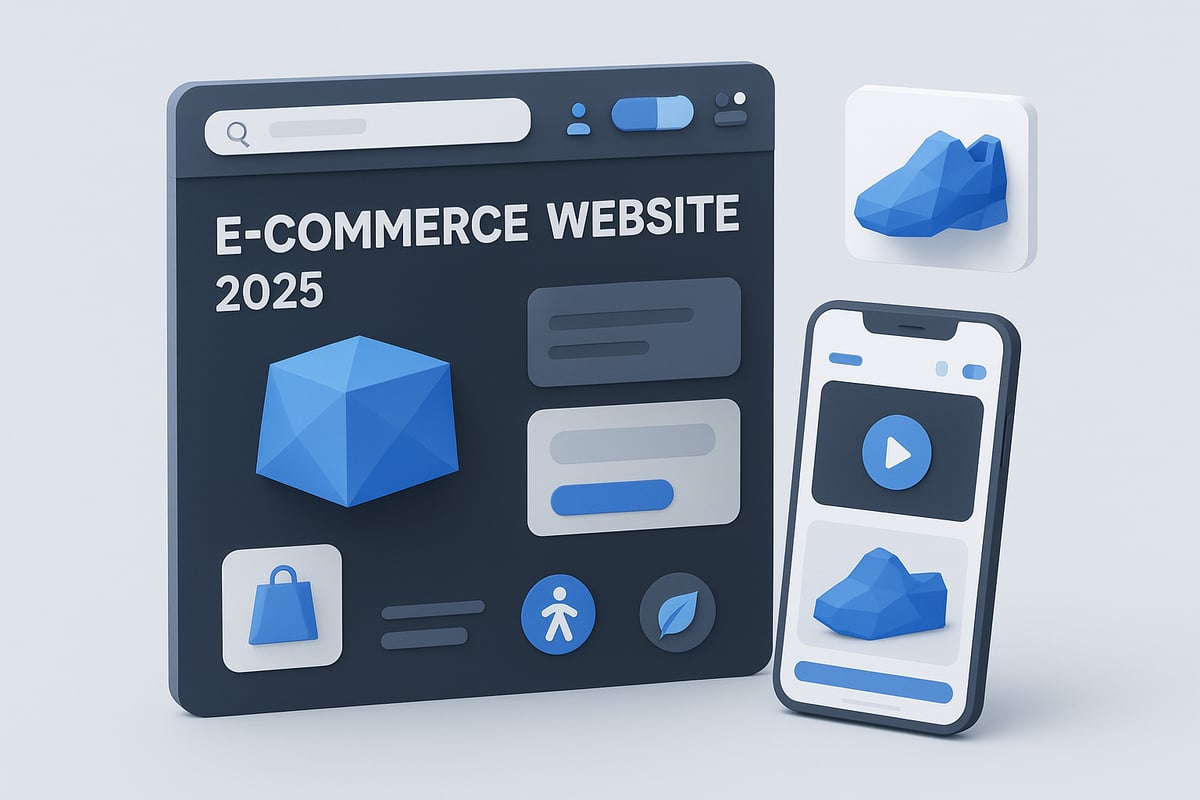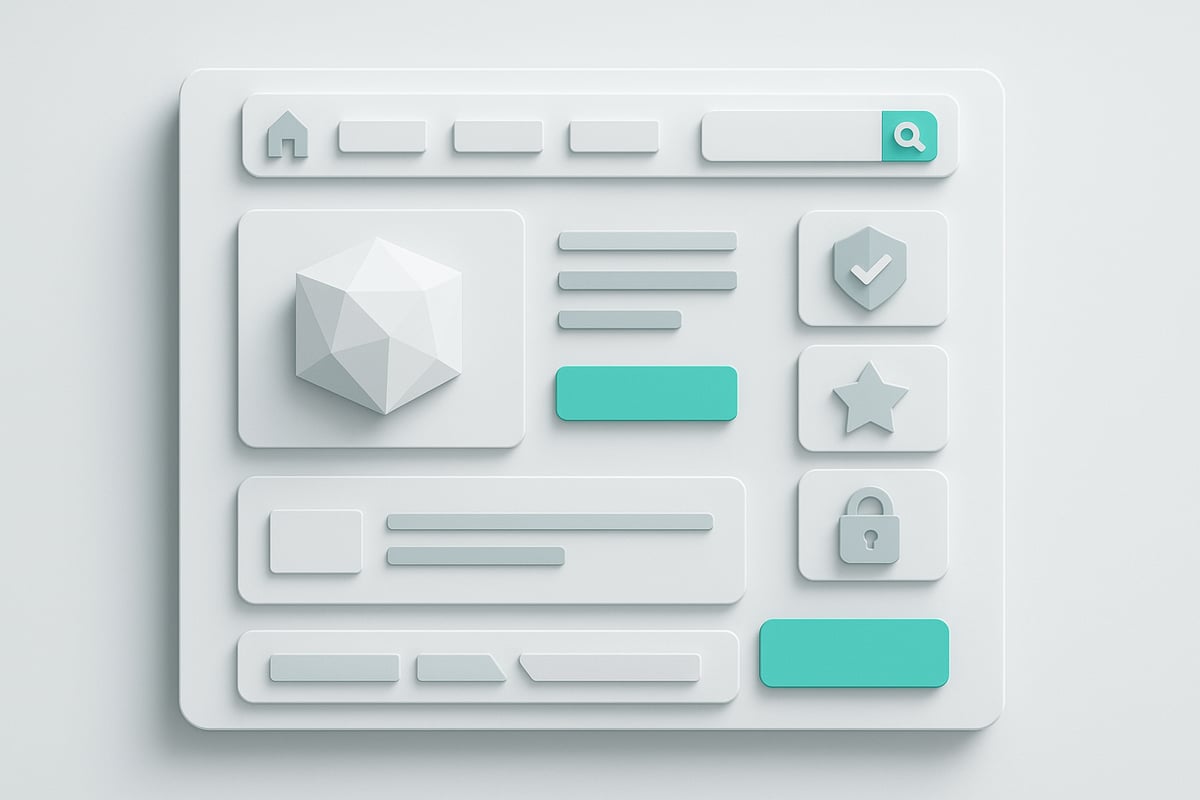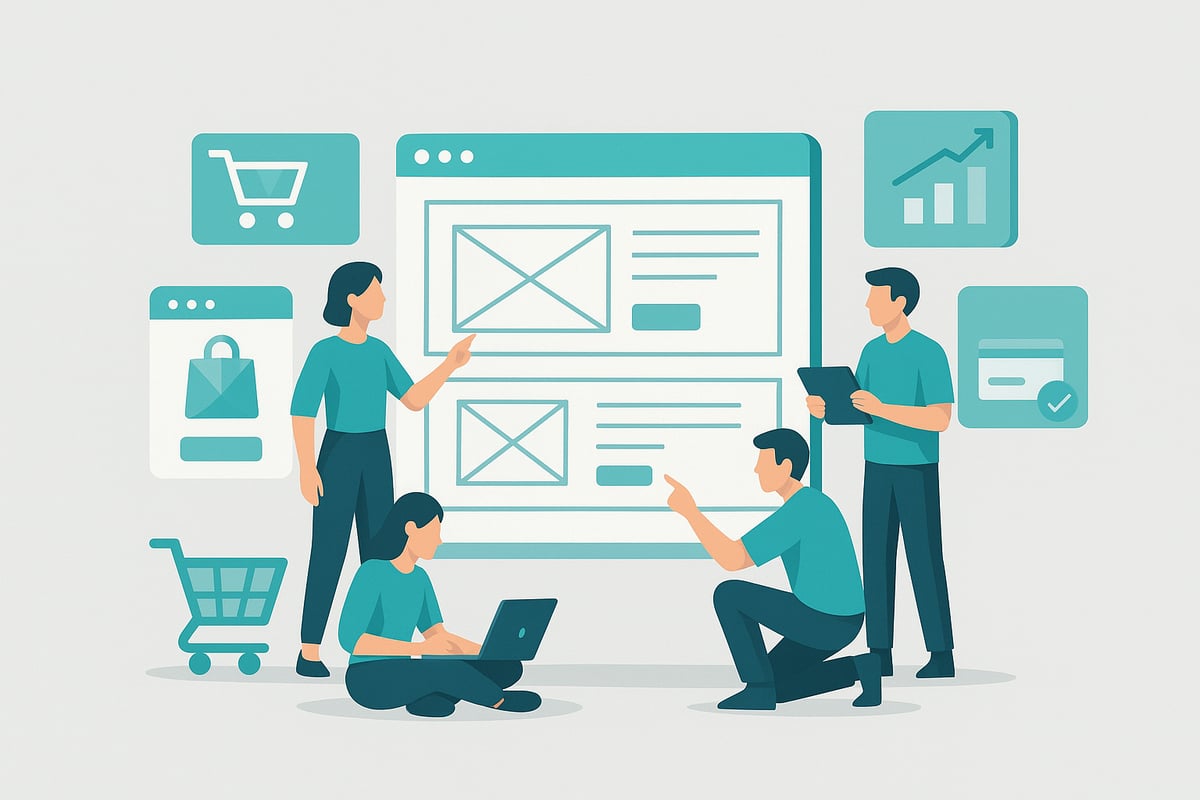Ecommerce is booming in 2025, and the competition to capture attention online has never been fiercer. A beautiful website is no longer enough; customers expect a seamless journey that guides them from browsing to checkout with ease.
In this guide, we take the mystery out of ecommerce web design and development, giving you the tools and insights to create an online shop that truly stands out. Whether you’re starting fresh or looking to upgrade, you’ll discover strategies and trends that help your business attract, engage, and convert more customers.
We’ll dive into the latest design trends, must-have user experience principles, best development practices, platform choices, and optimisation tips. Ready to future-proof your business and turn visitors into loyal customers? Let’s get started together.
Ecommerce Web Design Trends for 2025
Staying ahead in ecommerce web design and development is essential as we approach 2025. The digital landscape is shifting quickly, and your online shop needs to feel modern, accessible, and engaging. Let’s explore the trends shaping successful ecommerce websites this year, helping you connect with customers and boost conversions.

Embracing Minimalism and Micro-Interactions
Modern ecommerce web design and development is all about simplicity. Clean, distraction-free layouts make it easier for shoppers to focus on products, which can speed up decision-making and boost conversions.
Small interactive touches, such as micro-animations and hover effects, create a sense of delight and keep users engaged. For instance, ASOS’s minimalist product pages use subtle hover animations that highlight products without overwhelming the shopper.
Clean layouts reduce cognitive load
Micro-interactions offer instant feedback
Example: Subtle animations on ASOS product cards
Minimalism ensures your site looks fresh, loads quickly, and feels effortless to browse.
Dark Mode and Accessibility
Dark mode is more than just a design trend, it’s becoming a customer expectation. High-contrast designs help users shop comfortably at any time of day. Accessibility is also front and centre, with WCAG 2.2 standards guiding layouts, colours, and navigation.
Did you know that 15% of the global population lives with a disability that affects their web use (WHO)? Prioritising accessibility in ecommerce web design and development not only meets legal requirements, it also opens your shop to a wider audience.
Dark mode reduces eye strain
High-contrast improves readability
Accessible sites reach more customers
Designing for everyone shows that you care, making customers feel valued and welcome.
Personalisation and AI-Driven Experiences
Personalisation is redefining ecommerce web design and development in 2025. Shoppers expect sites to remember their preferences, show relevant products, and create tailored landing pages just for them. AI-driven recommendations, like Amazon’s “Recommended for You”, make shopping feel intuitive and personal.
If you’d like to explore how AI is transforming these experiences, check out this guide on AI-Powered Personalization in eCommerce.
Dynamic content adapts to each visitor
AI suggests products based on browsing
Personalised emails and offers boost loyalty
Building these smart features helps users feel seen and understood, increasing engagement and sales.
Mobile-First and Responsive Design
With over 73% of UK ecommerce sales now happening on mobile (Statista, 2024), mobile-first design is non-negotiable. Ecommerce web design and development must deliver seamless experiences on every device.
Use fluid grids, adaptive images, and thumb-friendly navigation to make browsing easy on any screen. Responsive sites keep customers happy, whether they’re shopping from a laptop or a phone.
Mobile-first layouts prioritise speed
Thumb-friendly menus improve usability
Responsive images reduce loading times
Meeting shoppers where they are builds trust and keeps them coming back.
Immersive Media: Video, AR, and 3D
Immersive media is elevating ecommerce web design and development by making online shopping more interactive. Product videos, AR try-ons, and 3D views let customers explore items in detail before they buy.
For example, IKEA’s AR app allows users to see furniture in their own space, helping them make confident decisions.
Product videos demonstrate features
AR try-ons increase customer confidence
3D models offer a closer look at products
These tools turn browsing into an experience, encouraging shoppers to add more to their baskets.
Sustainable and Ethical Design
Sustainability is now a core expectation in ecommerce web design and development. Shoppers look for eco-friendly visuals, carbon tracking badges, and honest messaging about sourcing and packaging.
Eco visuals signal brand values
Carbon badges build trust
Transparent messaging meets consumer demand
Aligning your website with ethical values attracts conscious consumers and strengthens your brand reputation.
Foundations of High-Converting Ecommerce Websites
Creating a high-performing online shop is about more than looks. The real success of ecommerce web design and development lies in building a seamless experience that guides visitors from browsing to buying with ease. Let's break down the essential building blocks every ecommerce site needs to thrive in 2025.

User-Centred Information Architecture
At the heart of ecommerce web design and development is a structure that puts the user first. Logical category groupings, tidy mega menus, and clear pathways help shoppers find what they need fast.
Well-labelled categories
Simple, predictable navigation
Prominent search bars
Take John Lewis as an example, where products are organised intuitively, reducing friction and boosting sales. For a deeper dive into structuring your site, explore these Ecommerce website design strategies.
Conversion-Focused Product Pages
Your product pages are the stage for conversion. Effective ecommerce web design and development here means:
Crisp, high-quality images
Persuasive, benefit-driven copy
Customer reviews and trust signals
Adding video can make a big difference. In fact, product videos can increase conversions by up to 80 percent, making them a smart investment for any online shop.
Streamlined Checkout Experiences
A complicated checkout is a conversion killer. The best ecommerce web design and development delivers:
Guest checkout options
One-click payment methods
Progress indicators
Did you know the average cart abandonment rate is 69.8 percent? Making checkout as pain-free as possible encourages more customers to complete their purchase.
Trust, Security, and Compliance
Trust is non-negotiable in ecommerce web design and development. Ensure your site displays:
SSL certificates and secure payment logos
GDPR compliance messaging
Well-known payment options like PayPal and Klarna
Visible trust badges and clear policies reassure customers, helping you build lasting relationships.
Fast Loading and Core Web Vitals
Speed is vital. Google’s Core Web Vitals are now ranking factors, so your ecommerce web design and development must prioritise:
Quick-loading pages
Mobile responsiveness
Optimised images and scripts
Remember, 53 percent of users abandon a site if it takes more than three seconds to load. Every second counts.
Social Proof and User-Generated Content
Social proof powers confidence. Add customer reviews, photo galleries, and social media integrations to showcase real experiences and build credibility. When your community is visible, trust and conversions naturally follow.
Step-by-Step Ecommerce Web Development Process
Embarking on the journey of ecommerce web design and development can feel overwhelming, but breaking it down into clear steps helps us stay focused and confident. Let’s walk through a proven process that transforms ideas into high-performing online shops, ready for 2025 and beyond.

Planning and Discovery
Every successful ecommerce web design and development project starts with thoughtful planning. We begin by defining our business goals and mapping out the needs of our target audience. Creating detailed user personas helps us understand shopper behaviour and expectations.
Analysing competitors and identifying unique selling points ensures our site stands out. Early-stage planning lays the groundwork for a digital experience that feels intuitive and engaging for every visitor.
Choosing the Right Ecommerce Platform
Selecting the right foundation is crucial in ecommerce web design and development. Platforms like Shopify, WooCommerce, Magento, and headless solutions each offer unique benefits. For example, Shopify powers over 4.4 million stores globally, making it a robust option for many businesses.
If you’re considering customisation or advanced features, exploring resources like the Custom ecommerce web development guide can help you make informed decisions. The right platform supports your growth, scalability, and customer experience goals.
Design Prototyping and Wireframing
Visualising your online shop before building it is essential. We use low or high-fidelity wireframes to map out layouts and user journeys. Tools such as Figma and Adobe XD allow teams to collaborate in real time, gathering feedback and refining ideas.
Prototyping ensures that every element, from navigation menus to product galleries, works harmoniously. This step reduces costly revisions later and creates a shared vision for the final site.
Front-End Development Best Practices
Front-end development brings designs to life in ecommerce web design and development. Responsive frameworks like Bootstrap and semantic HTML ensure your shop looks great on any device. Techniques such as CSS Grid and Flexbox create flexible layouts that adapt seamlessly.
Progressive Web Apps (PWAs) offer app-like experiences, boosting engagement and speed. Focusing on accessibility and mobile usability means every shopper feels welcome and empowered.
Back-End Development and Integrations
Behind the scenes, strong back-end development powers ecommerce web design and development. Secure payment gateways, inventory management, and CRM integrations keep operations running smoothly.
API-driven architectures enable scalability and flexibility as your business grows. Connecting essential systems streamlines workflows, reduces manual tasks, and ensures a seamless customer experience from browsing to checkout.
Testing and Quality Assurance
Before launching, rigorous testing is key. We check compatibility across browsers and devices, ensuring accessibility for all users. Automated testing tools like Selenium and Lighthouse catch errors early, saving time and reducing frustration.
Quality assurance covers everything from page speed to broken links, guaranteeing your ecommerce web design and development project meets the highest standards.
Launch, Monitoring, and Continuous Improvement
The launch is just the beginning of your ecommerce web design and development journey. We use go-live checklists to ensure nothing is missed, and set up analytics to monitor user behaviour and site performance.
Continuous improvement keeps your shop competitive. By analysing data and gathering feedback, we make ongoing updates that drive conversions and delight customers for years to come.
Essential Ecommerce Features and Integrations for 2025
Staying competitive in ecommerce web design and development in 2025 means offering features that customers expect and love. The right integrations and tools not only create a seamless shopping experience but also build trust and loyalty. Let's explore the must-have features shaping tomorrow’s online shops.

Advanced Search and Navigation
Shoppers want to find products quickly, so advanced search is essential for ecommerce web design and development. AI-powered search delivers fast, relevant results, while auto-suggestions help users refine their queries.
Faceted filtering lets customers sort by size, price, or brand.
Predictive search, as seen on Argos, speeds up product discovery.
Voice search and typo tolerance further improve accessibility.
These tools help visitors feel in control, making shopping enjoyable and efficient.
Flexible Payment Solutions
Payment flexibility is a key driver of conversions in ecommerce web design and development. Customers expect to choose from Apple Pay, Google Pay, Klarna, and Buy Now Pay Later (BNPL) options at checkout.
UK BNPL usage grew by 39% in 2024.
Multiple currencies and local payment methods boost inclusivity.
One-click checkout reduces friction and cart abandonment.
A smooth, transparent payment process gives customers confidence in your shop.
Omnichannel and Multi-Channel Selling
Selling across platforms is vital for ecommerce web design and development in 2025. Integrate your store with marketplaces like eBay and Amazon, plus social commerce on Instagram and TikTok.
Unified inventory and order management ensures accurate stock levels.
Seamless experiences help brands reach customers wherever they shop.
Adopting a Headless Commerce Overview approach enables flexible integrations and a consistent brand presence across all channels.
This strategy future-proofs your business and widens your reach.
Personalisation Engines
Personalisation is at the heart of modern ecommerce web design and development. AI-driven engines show dynamic recommendations, tailored content, and personalised emails.
Shoppers see products and offers relevant to their preferences.
Not On The High Street uses personalisation to suggest unique gifts.
Behavioural data enables custom landing pages and targeted promotions.
Personal touches make each visitor feel valued and understood.
Automated Marketing and CRM Tools
Automation streamlines engagement in ecommerce web design and development. Tools like Mailchimp, Klaviyo, or HubSpot send abandoned cart emails, automate loyalty schemes, and segment audiences.
Automated emails win back hesitant shoppers.
Loyalty programmes reward repeat customers.
CRM integrations centralise communication and boost retention.
This frees up time so you can focus on growing your business.
Analytics and Conversion Tracking
Data is the backbone of ecommerce web design and development success. Platforms like Google Analytics 4, heatmaps, and custom dashboards reveal how shoppers interact with your site.
Track conversions, bounce rates, and user journeys.
Identify high-performing products and pages.
Make data-driven decisions for ongoing optimisation.
With the right insights, you can continually improve the user experience.
Optimising Ecommerce Websites for SEO and Performance
Optimising your ecommerce web design and development for both SEO and site performance is no longer optional in 2025. Search engines and shoppers alike expect lightning-fast, intuitive, and well-structured experiences. Let’s explore the essential areas you should focus on to keep your site at the top of search results and in the hearts of your customers.
Technical SEO Fundamentals
The foundation of every successful ecommerce web design and development project is strong technical SEO. Ensuring your site is crawlable, well-structured, and easy for search engines to understand is vital. Use schema markup, generate XML sitemaps, and maintain an updated robots.txt file.
Did you know 68% of online experiences begin with a search engine? For more on aligning web design with SEO, see these web design SEO best practices.
On-Page Optimisation
On-page optimisation is the art of making every product and category page shine for both users and search engines. Unique product descriptions, optimised images, and structured data help your ecommerce web design and development stand out.
SEO-friendly URLs, like those used by ASOS, create clarity for both Google and your shoppers. Remember, every element should enhance discoverability and relevance.
Site Speed and Performance Optimisation
Fast-loading pages are a must. Compress images, use lazy loading, and distribute content with a CDN to keep your ecommerce web design and development running smoothly.
Google’s Core Web Vitals should be your north star: aim for strong LCP, FID, and CLS scores. A staggering 53% of users will leave if your site takes over three seconds to load, so every millisecond counts.
Mobile SEO and Voice Search
As mobile commerce dominates, mobile-first strategies are at the heart of ecommerce web design and development. Prioritise mobile-friendly layouts, responsive images, and intuitive navigation.
Voice search is also on the rise, with 27% of the global online population using it on mobile. Optimise for conversational queries and make your local SEO shine, ensuring your shop is always within reach.
Content Marketing and Blogging
Content is your secret weapon for driving organic traffic and engaging visitors. Create buying guides, how-to articles, and video content that speaks to your audience’s needs.
A blog like MADE.com’s interior inspiration section not only boosts SEO, but also builds trust and keeps shoppers coming back. Consistent, relevant content helps position your brand as an authority.
Link Building and Digital PR
Building quality backlinks signals trust and authority to search engines. Partnerships, influencer collaborations, and press mentions all help raise your ecommerce web design and development profile.
Engage with digital PR campaigns and consider collaborating with niche communities. Genuine, relevant links are far more valuable than quantity alone in today’s competitive landscape.
We’ve covered a lot together—from the latest ecommerce design trends to building high converting sites and future proofing your business for 2025. If you’re excited to put these ideas into action, why not let us help make your vision a reality? At Futur Media, we’re passionate about creating online shops that truly stand out and drive real results. Whether you’re starting fresh or looking to revamp your site, we’re here to support you every step of the way. Ready to take the next step with a Shopify Agency?
Start Project

